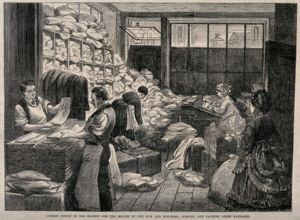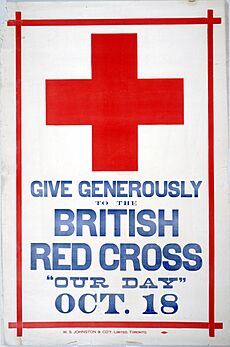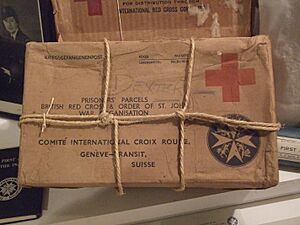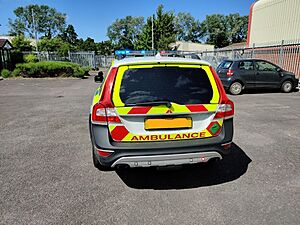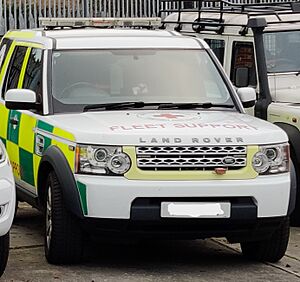British Red Cross facts for kids
 |
|
| Founded | 4 August 1870 |
|---|---|
| Legal status | Incorporated by royal charter, 1908 |
| Focus | Humanitarian aid |
| Location |
|
|
Patron
|
King Charles III |
|
Deputy President
|
Princess Alexandra |
| Béatrice Butsana-Sita | |
|
Key people
|
Chair Youth Leadership Team, Andrea Ando |
|
Main organ
|
Board of Trustees - chairperson, Liz Padmore |
|
Revenue (2023)
|
£331 million |
|
Staff (2023)
|
3,548 |
|
Volunteers (2023)
|
10,500 |
|
Formerly called
|
British National Society for Aid to the Sick and Wounded in War |
The British Red Cross Society is the UK part of a big global group called the International Red Cross and Red Crescent Movement. This group helps people in need all over the world. The British Red Cross started in 1870. It is a charity with about 10,500 volunteers and 3,500 staff members.
Their main goal is to help people during tough times, both in the UK and in other countries. The Red Cross helps everyone, no matter where they come from, what they believe, or their religion. King Charles III became their patron in May 2024. Before that, Queen Elizabeth II was the patron until she passed away in 2022.
In 2023, the charity received £331 million. Most of this money, about £246 million, was used to help people through their programs.
Contents
- What Guides Them
- History of the British Red Cross
- How the British Red Cross is Organized
- Overseas Help
- What the British Red Cross Does
- First Aid and Ambulance Services
- First Aid Training
- Fire and Emergency Support (FESS)
- Medical Equipment Loan
- Humanitarian Education
- Health and Social Care
- Refugee Support Services
- Finding Lost Family Members
- International Disaster Relief
- Health and Care Abroad
- HIV Awareness
- Youth Engagement
- What They Did in a Year
- How They Raise Money
- British Red Cross Museum
- Awards and Honours
- See Also
What Guides Them
The British Red Cross wants to help people and communities get ready for, deal with, and recover from a crisis. Their motto is 'refusing to ignore people in crisis'.
Everyone who works or volunteers for the Red Cross follows seven main rules. These rules are for the whole International Red Cross and Red Crescent Movement:
- Humanity: Being kind and caring.
- Impartiality: Helping everyone equally.
- Neutrality: Not taking sides in conflicts.
- Independence: Making their own decisions.
- Voluntary Service: Helping without wanting money.
- Unity: Only one Red Cross society in each country.
- Universality: The Red Cross is a worldwide movement.
The British Red Cross also has four values that guide how they work:
- Compassion: Showing care and understanding.
- Inclusivity: Making sure everyone feels welcome.
- Dynamism: Being active and full of energy.
- Courage: Being brave when facing challenges.
History of the British Red Cross
How it Started
The British Red Cross began in 1870. This was just seven years after the international Red Cross movement started in Switzerland. It happened because of the Franco-Prussian War (1870–1871). Many countries in Europe were forming similar groups to help.
The society was first called the British National Society for Aid to the Sick and Wounded in War. It was founded in London on August 4, 1870. They helped soldiers from both sides of the Franco-Prussian War. They worked under the protection of the Red Cross symbol. Queen Victoria was the first patron of the organization.
In 1905, the society changed its name to the British Red Cross Society. In 1908, King Edward VII gave them their first special royal charter. He also became their patron. His wife, Queen Alexandra, became its president. Later, other kings and queens, like King George V, King George VI, and Queen Elizabeth II, became patrons. King Charles III was the society's president from 2003 to 2024. He became the patron in May 2024.
First World War Efforts
When the Great War started in 1914, the British Red Cross teamed up with the Order of St John Ambulance. They formed the Joint War Organisation. They shared their resources and created groups called Voluntary Aid Detachments (VADs). These VAD members were trained in first aid, nursing, and cooking. They worked in hospitals, rest stops, and supply centers.
The Joint War Organisation also helped on the front lines. They sent the first motorized ambulances to battlefields. These were much faster than the old horse-drawn ones. They also set up centers to record wounded and missing soldiers. Red Cross volunteers searched for people and noted down names. This started the international Message and Tracing service, which still helps families find each other today.
One interesting thing they did was train Airedale Terrier dogs. These dogs helped search for wounded soldiers on battlefields.
Between the World Wars
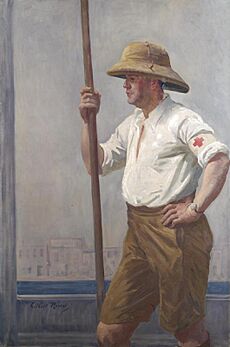
After the First World War ended in 1919, the League of the Red Cross was formed. This group is now called the International Federation of Red Cross and Red Crescent Societies. National Red Cross groups started to do more. They focused on improving health, preventing diseases, and reducing suffering around the world.
The British Red Cross helped start new Red Cross societies in many parts of the British Empire. Most of these are now independent groups.
In 1924, the British Red Cross started its youth movement. This helped teach its values to younger people.
Second World War Efforts
When war was declared again in 1939, the British Red Cross once more joined with St John. They formed the Joint War Organisation. This meant St John volunteers were also protected by the Red Cross symbol.
The organization worked in hospitals, care homes, and ambulance units. Much of their work was paid for by a special appeal. By 1946, this appeal had raised over £54 million.
The Red Cross also sent parcels to prisoners of war. These parcels followed rules set in 1929 about how prisoners should be treated. The Joint War Organisation sent food, medical supplies, books, and games. During the war, they sent over 20 million food parcels.
They also helped people in the Channel Islands when Germany occupied them. The Red Cross ship SS Vega brought food parcels to stop people from starving.
After the Wars
After the Second World War, the British Red Cross focused on helping many civilians who had been forced to move. They provided basic supplies and helped families find each other again. This work led to new rules in 1949 to protect civilians during war.
Since then, the British Red Cross has helped people in many crises worldwide. This includes the Hungarian Revolution of 1956 and famines in Africa in the 1980s. While their volunteers no longer go abroad, the British Red Cross sends skilled staff to help with international emergencies.
In the UK, they have helped at many major disasters. These include the Aberfan disaster in 1966 and the 7 July 2005 London bombings. They offer medical help, run helplines for worried families, and provide emotional support.
In 2008, the Prince of Wales and the Duchess of Cornwall hosted a party. It celebrated 100 years since the society received its royal charter.
How the British Red Cross is Organized
The UK government sees the British Red Cross as one of three main volunteer aid groups. The other two are St John Ambulance and St. Andrew's First Aid. The British Red Cross is the only Red Cross society for the United Kingdom and its overseas territories.
Overseas Help
The British Red Cross has branches in several overseas territories:
They also used to have a branch in British Hong Kong before 1997.
What the British Red Cross Does
The British Red Cross is a key part of the emergency services. They help the government and other emergency groups during crises. They provide many services, from first aid to helping people after a disaster.
All their services can be used during an emergency. For example, their care teams can help people at a rest center. Their ambulances can help the NHS care for injured people.
The British Red Cross has helped at many big emergencies. These include the 7 July 2005 London bombings, the Manchester Arena bombing, and the Grenfell Tower fire. They work across the UK, 24 hours a day. They do not send their volunteers abroad. Instead, the Red Cross group in the affected country handles overseas disasters.
Besides emergency response, the British Red Cross also works in other areas:
First Aid and Ambulance Services
Event First Aid
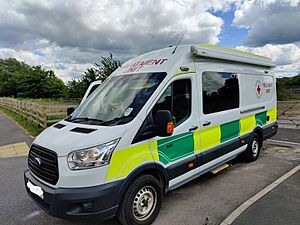
The Red Cross is the biggest provider of first aid in the world.
In the UK, the British Red Cross was well known for providing first aid at public events. This included football games, concerts, and big running events. However, they stopped providing Event First Aid services on March 31, 2020.
Ambulance Support
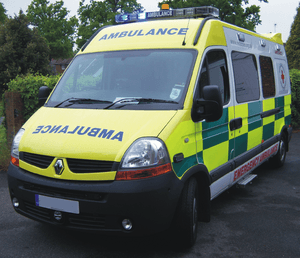
The British Red Cross offers three main types of ambulance support:
- Patient transport: Moving patients between places.
- Urgent patient transport: For patients who need quick transport.
- Emergency response (999 calls): Responding to serious emergencies.
They also provide ambulance services during busy times or bad weather. For example, they use 4x4 ambulances in snow.
There are different levels of staff:
- Ambulance care assistant (ACA): Helps move patients who are not in an emergency.
- Ambulance crew: Provides emergency or urgent transport.
- Ambulance technician (EMT): Has advanced training.
- Paramedic: A highly trained medical professional.
British Red Cross ambulance crews are well trained. They often work with NHS ambulance services during busy periods. They respond to 999 calls from the public.
Fleet Support
The Fleet Support team is a group of volunteers. They take care of the vehicles used by the Ambulance Support team. Their duties include:
- Washing and cleaning ambulances and other vehicles.
- Driving vehicles between different locations.
- Doing basic checks like filling windscreen wash and checking tires.
- Helping with supplies and equipment.
First Aid Training
The British Red Cross teaches first aid across the UK. They train people for work and for their communities. Their commercial courses help people get skills for their jobs. Over 120,000 people are trained each year. Courses range from basic life support to a three-day First Aid at Work course.
They also offer many first aid courses to the public. They reach out to schools, community groups, and other groups. One project, Everyday First Aid, helps people who might not usually get training, like those with disabilities.
Red Cross first aid training helps people learn skills and feel confident using them. They combine classroom learning with hands-on practice.
Fire and Emergency Support (FESS)
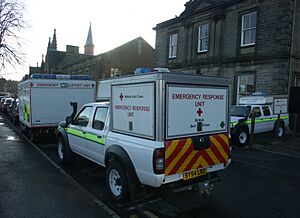
This service helps people right after emergencies like a house fire or car crash. It covers most of the UK. A team of two volunteers with a special vehicle responds when the local fire and rescue service asks for help.
They provide shelter, food, first aid, clothing, and toiletries. They also offer emotional support. Volunteers help people deal with housing departments or insurance companies.
These teams also help firefighters and other emergency services at big incidents. They might provide refreshments or a listening service for those affected by what they have seen. They also help set up reception centers for survivors and families.
Medical Equipment Loan
The British Red Cross lets people borrow wheelchairs for free. This service is available across the United Kingdom, including Northern Ireland. They have nearly 1,000 offices that offer this. This service is run by their Health and Social Department.
Humanitarian Education
This service helps people learn about the world and what it means to be human. It's not about religion or politics. It focuses on how we can help each other and reduce suffering. Humanitarian education helps students think about why people help others. It also explores the complex issues that come up when people help each other.
The British Red Cross provides learning materials for teachers. They also train young people to teach others. In 2008, they launched an online game called "Traces of Hope." It taught people about the Red Cross's work in conflict areas and how war affects civilians.
Health and Social Care
Care in the Home
In some areas, the British Red Cross offers short-term care. This is for people who have just left the hospital or had an injury. Volunteers visit people's homes and help with daily tasks. This could be shopping or getting prescriptions. They help people stay independent and feel good.
Teams also work in hospitals to drive patients home and help them settle in. They follow up with a phone call the next day. If needed, they can refer people to a "Home from Hospital" scheme. This scheme provides up to six weeks of support, like help with shopping or befriending.
Therapeutic Care
British Red Cross volunteers also work in hospitals and care homes. They give patients relaxing massages of the head, neck, shoulders, and hands. This helps people feel calm and well, especially during stressful times.
Crisis Intervention Community Support
This service helps people in Derbyshire, Nottinghamshire, and Cheshire. It provides emotional support during a crisis. It also helps people keep their independence. This service can help prevent people from needing to go to the hospital or a care home.
Transport Service
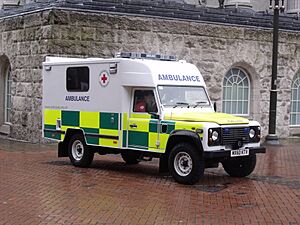
The British Red Cross offers transport for people who find it hard to get around. This could be by car or minibus. They help people go to medical appointments or shops. Some areas have "Dial-a-Ride" schemes. Here, elderly or disabled people can call for a special minibus to pick them up.
They also provide ambulance transport between treatment places or for hospital admissions. This is done by the same trained ambulance crews who respond to emergencies.
Refugee Support Services
Since 1989, the British Red Cross has helped refugees. They manage reception centers for refugees across the country. They help provide basic needs like shelter and food. If people have nothing, the Red Cross can give short-term emergency help and advice. They also have a befriending service for vulnerable refugees, like young people and women.
The British Red Cross can also help when many people arrive in the UK at once.
Finding Lost Family Members
This is a special international service. Most Red Cross and Red Crescent societies around the world offer it. It started to help war refugees find family. Now, it helps anyone who has lost touch with family because of war or disaster. The global Red Cross network uses local volunteers to find relatives. They help people reconnect or simply pass messages.
The British Red Cross also helps people separated by the Second World War.
International Disaster Relief
The International Red Cross and Red Crescent Movement is worldwide. This means there are volunteers in the country affected by a disaster. However, the British Red Cross also sends paid staff, called delegates, abroad. These delegates have special skills, like in logistics. They help other agencies after a major international disaster.
The British Red Cross also helps communities recover after a disaster. They help prepare communities for future emergencies.
Health and Care Abroad
The British Red Cross works with other Red Cross societies. They aim to improve health and care for vulnerable communities in other countries.
They have supported HIV work internationally since the mid-1980s. This includes work in China, South Africa, and Ethiopia. The charity helps fight Tuberculosis in countries like Turkmenistan and Russia. They raise awareness and support affected people in their homes. They also help with clean water and sanitation in several African countries and Cambodia.
The British Red Cross also supports healthcare programs in conflict areas, like Iraq and Sudan.
HIV Awareness
The British Red Cross helps the Red Cross and Red Crescent Movement fight HIV and AIDS worldwide. They work with young people to stop discrimination and reduce carelessness about catching the disease. On World AIDS Day (December 1) in 2007, they launched an online campaign called "HIV: What's the story?". It aimed at young people in the UK and other countries. The campaign used social media sites like Facebook.
Youth Engagement
The British Red Cross won the Queen Elizabeth II Platinum Jubilee Award for Volunteering. This was for their work in helping young people become leaders.
What They Did in a Year
In 2010, the British Red Cross did many things:
- They gave water, food, and shelter to over 420,000 people after 25 disasters overseas.
- They trained 221,970 people in first aid in the UK.
- They provided first aid at 9,533 public events.
- They responded to 2,102 emergencies in the UK.
- They helped 7,109 victims of fire.
How They Raise Money
The British Red Cross is a charity. They rely a lot on donations from people and organizations. They also earn money from services like First Aid Training for workplaces.
Donations from individuals are important. But large donations from companies can make a huge difference. For example, being the Tesco charity of the year in 2007 brought in a lot of money.
Many events are held each year to raise money. These include sponsored bike rides, walks, and skydives. Red Cross Appeal Week happens every May. This is around the birthday of the Red Cross founder, Henry Dunant. During this week, staff and volunteers collect money in public places.
The British Red Cross also gets funds from Will Aid. This scheme lets people have a basic will written for free. In return, they are asked to donate to charity.
Famous Supporters
To get more support, the Red Cross has several celebrity ambassadors. These include Angela Rippon, Michael Buerk, James McAvoy, and Konnie Huq.
British Red Cross Museum
The British Red Cross has a museum. It shows items from when they started in 1870 until today. The museum is part of The London Museums of Health & Medicine group. You can see posters, photos, badges, medals, medical equipment, and fundraising items.
The museum is free to enter. You can visit without booking. But if you want a guided tour or to do research, you need to book ahead.
Awards and Honours
- The Voluntary Medical Service Medal can be earned by volunteers. They get it after 15 years of service. They get an extra clasp for every five more years. St. Andrew's First Aid in Scotland also gives this medal.
- British Red Cross Badge of Honour: This is an award given by the organization.
See Also


